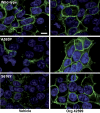Rescue of expression and signaling of human luteinizing hormone G protein-coupled receptor mutants with an allosterically binding small-molecule agonist
- PMID: 21482767
- PMCID: PMC3084114
- DOI: 10.1073/pnas.1015723108
Rescue of expression and signaling of human luteinizing hormone G protein-coupled receptor mutants with an allosterically binding small-molecule agonist
Abstract
Naturally occurring mutations of G protein-coupled receptors (GPCRs) causing misfolding and failure to traffic to the cell surface can result in disease states. Some small-molecule orthosteric ligands can rescue such misfolded receptors, presumably by facilitating their correct folding and shuttling to the plasma membrane. Here we show that a cell-permeant, allosterically binding small-molecule agonist (Org 42599) rescues the folding and cell surface expression, and therefore target cell signaling, of mutant human luteinizing hormone (LH) receptors (A593P and S616Y) that cause Leydig cell hypoplasia in man. Both mutant receptors were retained in the cytoplasm whereas WT receptor localized at the cell membrane, and binding of LH to cells expressing the mutant receptors was markedly lower than to those expressing the WT receptor. Incubation with Org 42599 increased mutant receptor expression, cell surface localization, and the proportion of mutant receptor in the mature glycosylated form. Importantly, although LH stimulated little (S616Y) or no (A593P) activation of cells expressing mutant receptors, incubation of cells with Org 42599 facilitated rescue of expression and stimulation by the native ligand, LH. Although Org 42599 could activate these receptors, it could not displace (125)I-labeled human LH binding to the WT receptor, indicating that it acts in an allosteric manner. Here we demonstrate a small-molecule GPCR allosteric agonist that functionally rescues intracellularly retained mutant LH receptors by facilitating their cell surface expression. This approach may have application for treatment of infertile patients bearing such mutations and, more broadly, for other misfolded GPCR mutants resulting in human pathologic processes.
Conflict of interest statement
Conflict of interest statement: C.J.v.K. and R.v.d.L. are paid employees of Merck Sharp and Dohme.
Figures





Similar articles
-
Rescue of Function of Mutant Luteinising Hormone Receptors with Deficiencies in Cell Surface Expression, Hormone Binding, and Hormone Signalling.Neuroendocrinology. 2021;111(5):451-464. doi: 10.1159/000508000. Epub 2020 Apr 21. Neuroendocrinology. 2021. PMID: 32316022
-
Rescue of Cell Surface Expression and Signaling of Mutant Follicle-Stimulating Hormone Receptors.Endocrinology. 2021 Dec 1;162(12):bqab134. doi: 10.1210/endocr/bqab134. Endocrinology. 2021. PMID: 34192304
-
A signaling-selective, nanomolar potent allosteric low molecular weight agonist for the human luteinizing hormone receptor.Naunyn Schmiedebergs Arch Pharmacol. 2008 Nov;378(5):503-14. doi: 10.1007/s00210-008-0318-3. Epub 2008 Jun 13. Naunyn Schmiedebergs Arch Pharmacol. 2008. PMID: 18551279
-
Regulatory processes governing the cell surface expression of LH and FSH receptors.Subcell Biochem. 2012;63:113-29. doi: 10.1007/978-94-007-4765-4_7. Subcell Biochem. 2012. PMID: 23161136 Review.
-
[New achievements in the development and study of the mechanisms of action of the low molecular weight agonists of receptors of the thyroid-stimulating and the luteinizing hormones].Tsitologiia. 2015;57(3):167-76. Tsitologiia. 2015. PMID: 26021165 Review. Russian.
Cited by
-
Targeting trafficking as a therapeutic avenue for misfolded GPCRs leading to endocrine diseases.Front Endocrinol (Lausanne). 2022 Aug 25;13:934685. doi: 10.3389/fendo.2022.934685. eCollection 2022. Front Endocrinol (Lausanne). 2022. PMID: 36093106 Free PMC article. Review.
-
Misfolding Ectodomain Mutations of the Lutropin Receptor Increase Efficacy of Hormone Stimulation.Mol Endocrinol. 2016 Jan;30(1):62-76. doi: 10.1210/me.2015-1205. Epub 2015 Nov 10. Mol Endocrinol. 2016. PMID: 26554443 Free PMC article.
-
Pharmacoperones as Novel Therapeutics for Diverse Protein Conformational Diseases.Physiol Rev. 2018 Apr 1;98(2):697-725. doi: 10.1152/physrev.00029.2016. Physiol Rev. 2018. PMID: 29442594 Free PMC article. Review.
-
Pharmacological folding chaperones act as allosteric ligands of Frizzled4.Nat Chem Biol. 2015 Apr;11(4):280-6. doi: 10.1038/nchembio.1770. Epub 2015 Mar 9. Nat Chem Biol. 2015. PMID: 25751279
-
Small Molecule Follicle-Stimulating Hormone Receptor Agonists and Antagonists.Front Endocrinol (Lausanne). 2019 Jan 23;9:757. doi: 10.3389/fendo.2018.00757. eCollection 2018. Front Endocrinol (Lausanne). 2019. PMID: 30728807 Free PMC article. Review.
References
-
- Kremer H, et al. Male pseudohermaphroditism due to a homozygous missense mutation of the luteinizing hormone receptor gene. Nat Genet. 1995;9:160–164. - PubMed
-
- Misrahi M, et al. Comparison of immunocytochemical and molecular features with the phenotype in a case of incomplete male pseudohermaphroditism associated with a mutation of the luteinizing hormone receptor. J Clin Endocrinol Metab. 1997;82:2159–2165. - PubMed
-
- Leung MY, et al. Biological effect of a novel mutation in the third leucine-rich repeat of human luteinizing hormone receptor. Mol Endocrinol. 2006;20:2493–2503. - PubMed
-
- Huhtaniemi I, Alevizaki M. Gonadotrophin resistance. Best Pract Res Clin Endocrinol Metab. 2006;20:561–576. - PubMed
Publication types
MeSH terms
Substances
Grants and funding
LinkOut - more resources
Full Text Sources

